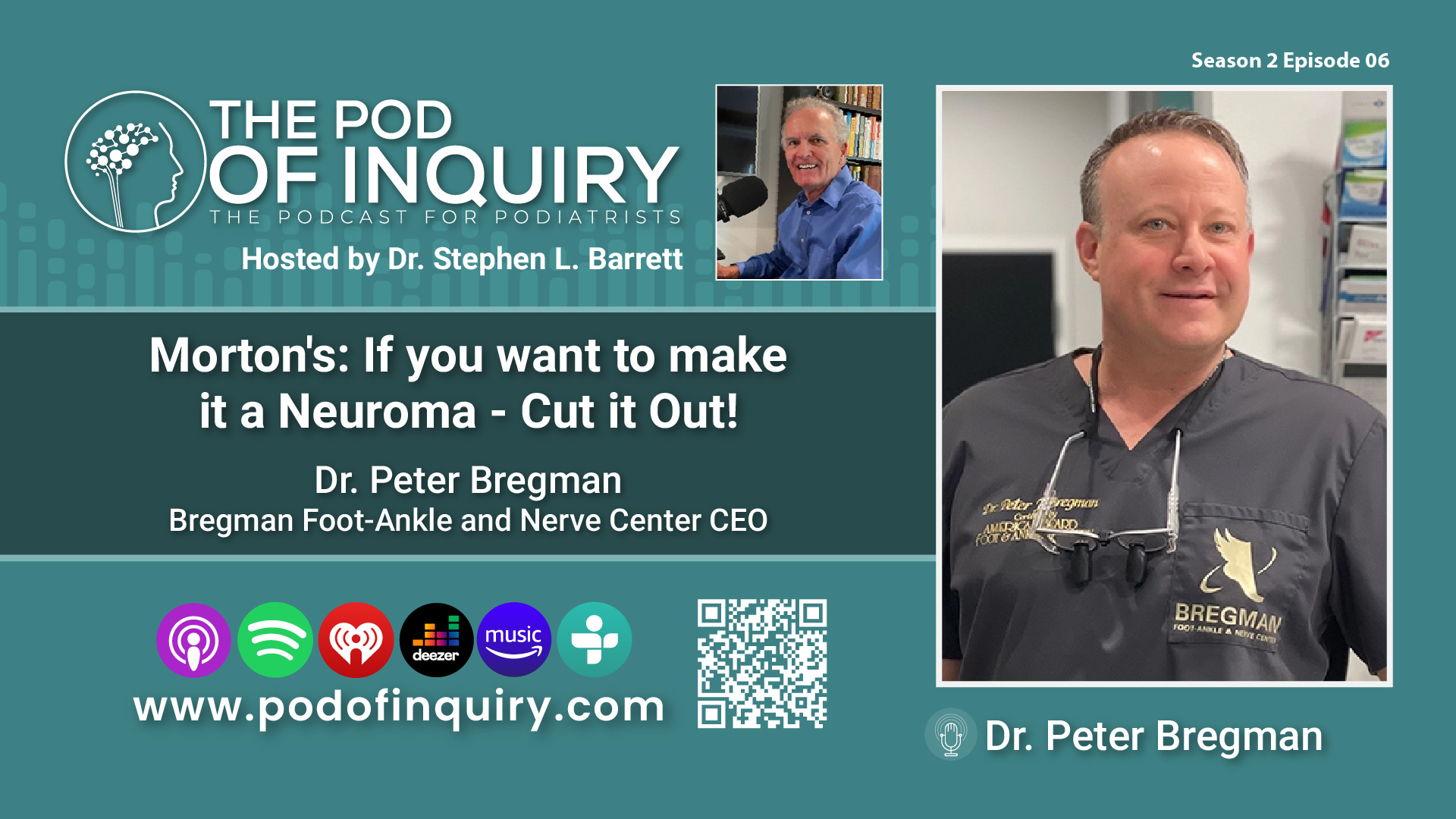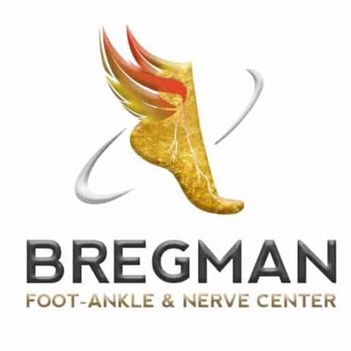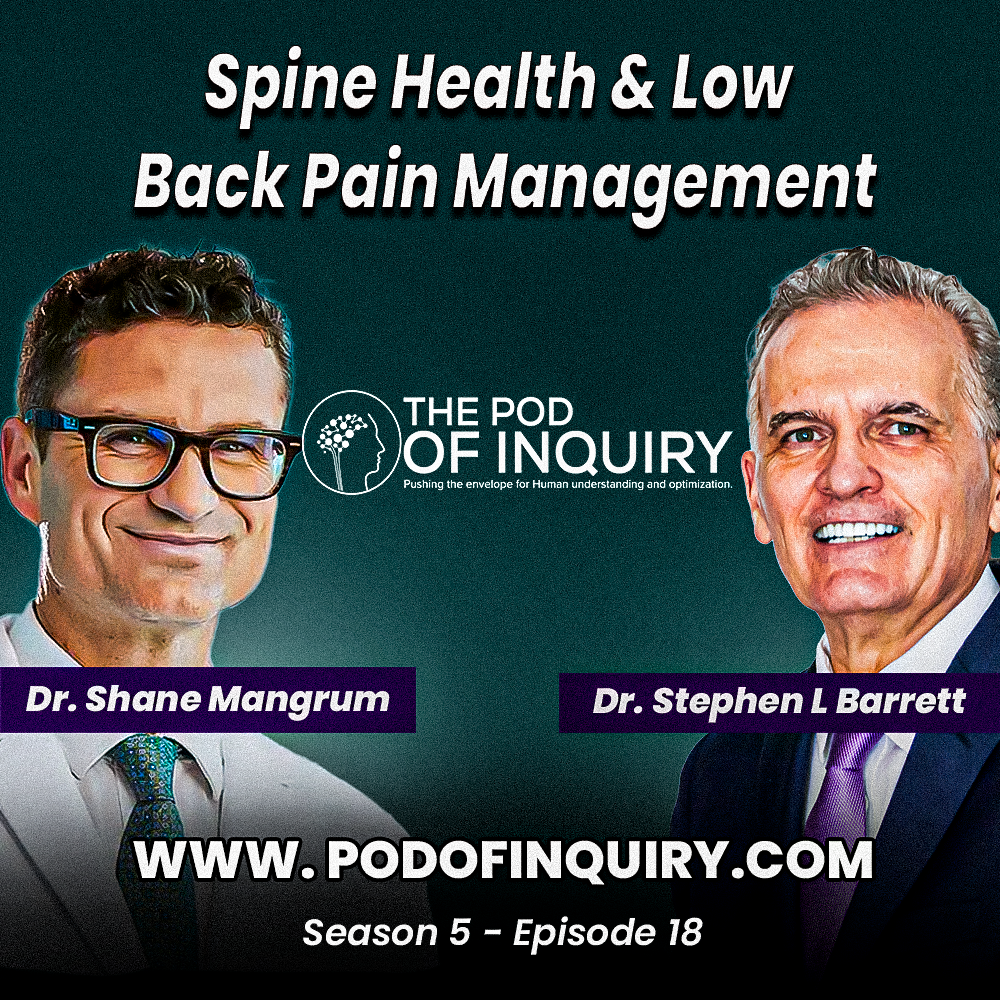This week Dr. Peter Bregman and I discuss Morton’s entrapment and how if you want to make it a Neuroma all you have to do is cut it out. We get into considerations of sclerosing injections, the use of Sarapin, and some other cool stuff. I think you will enjoy hearing this conversation.

Dr. Peter J. Bregman, DPM, has often been recognized as an expert in complex foot and ankle conditions, as well as sports injuries. As the founder of Bregman Foot-Ankle & Nerve Center in Las Vegas, Dr. Bregman welcomes new and existing patients to the practice. He was just voted a TopDoc by MyVegas magazine which recognizes the best doctors in Las Vegas. He has consistently been in the Top 3 best foot doctors since he came to Las Vegas. He has treated professional athletes from the NFL and NHL as well as celebrities.
Show Notes
The Nomenclature of Morton’s neuroma. [02:49]
- Many doctors haven't been exposed to nerve decompression; it's been negative for whatever reason.
- Our job is to educate as many people.
- An article was published in 2005 on the nomenclature of Morton's entrapment.
- You can go back to Civinini in 1835 and then Morton. None of them really ever used the word neuroma; they used metatarsalgia.
- A guy named Sandal in 1958 writes a paragraph letter to the editor of JAPMA and uses the term Morton neuroma.
- Until that time, it was always referred to as some something other than neuroma.
- In order for it to be a neuroma, it has to have physiological injury to it.
The role of nerve decompression. [07:14]
Nerve entrapment and success rates. [13:20]
“The whole concept is to really think of this as a nerve entrapment because that's what it really is.” Dr. Barrett
- If you look at the literature, there's this magic number of 85%.
- “It's 85% get better after neurectomy.”
- Barrett feels like that's not true.
- Womack and Richardson published a study of about 120 patients.
- They found that half of their patients that they did neurectomies on got better.
- The other half were either miserable or fair.
- Some of this stuff just gets regurgitated in the literature over and over and it becomes true, not because it is true, but because it's been cited to be true.
- Some podiatrists say they have a 95% success rate in neurectomies.
- This one particular guy who just retired recently said that he has done hundreds and 99% of them got better.
- There's no way that's possible.
- The endoscopic decompression for Morton's was introduced in 1993-1994 and was then talked about on one of the PBS stations.
- A three-minute little segment on this new decompression endoscopic technique.
- The office got about 220 phone calls following the airing of that segment.
- Out of that 220, 200 of them were failed Morton’s neurectomies.
- There's a lot of surgeries that may not have the ultimate outcome, but patients can get through it.
- If you have a bad failed neurectomy or a bad complication, the patient gets CRPS.
“If somebody says that it's 99%, you might want to slowly back out of that office as fast as you can.”
You're not getting caught because you're not taking enough money. [19:56]
- These doctors who are doing the neurectomies are not informing the patients about what the downsides are.
- They don’t mention stump neuroma as a real possibility where you're going to be three times worse than you were before the surgery.
- Neurectomy for Morton's entrapment is a bad surgery to begin; it's treating something but not in the optimal way.
- It’s like you're robbing the bank, and you're getting away with it a lot.
- The people that get messed up, really get messed up.
- A lot of people can live with it, but they're miserable or they're compensating
- The severe complications from a Morton’s neurectomy can be catastrophic for a patient and really life changing.
- A lot of people want to try to do anything else that they possibly can.
- Pseudo conservative things like ethanol or alcohol, sclerosing injections, radiofrequency ablation.
“A global understanding of their condition really puts you into a good framework for rendering some type of intervention.”
- Just like any standard patient that comes in with a complaint, you want to make sure you have a thorough history and understanding if they're on drugs that potentially could be neurotoxic.
- If they've had chemotherapy, if they have any other proximal pathologies
- Double crush or triple crush; crushes anywhere in spinal column outside the CNS that's causing a compression on the nerve, or slowing of the nerve, or tightening of that higher off is going to affect you down below.
- In Morton's nerve entrapment, you definitely want to rule out tarsal tunnel syndrome
- You don't have four neuromas in your foot, you probably have tarsal tunnel syndrome and maybe one or two neuromas.
Diagnosing and treating nerve entrapment. [25:05]
- Once it is truly a neuroma, confirm it with diagnostic nerve blocks under ultrasound guidance and see how they respond.
- People who come in with failed Morton’s neurectomies, and have an equinus condition and a ruptured plantar plate--usually the second metatarsal phalangeal joint.
- They have a huge tyloma and nobody's looking up north to see why the forefoot is under so much pressure.
- The great thing about the ultrasound is it's really easy to take a look at the plantar plate.
- An article on 193 endoscopic decompressions was published.
- It was four different surgeons
- The cumulative success rate for third interspace was about 95%; for second interspace, it dropped down to about 85%.
- It appeared that the reason the patients still had pain second interspaces because they had an additional element of pathology.
- Either a partial or very severe plantar plate rupture that was just not addressed.
- That is a real key for people that are looking at Morton's entrapments.
- People don't think about what's going on biomechanically.
- Why is this foot have this big callus all over it?
- Especially if they present with more than one interspace, that's a red flag.
- Bregman shies away but may look at again is Shockwave.
- There are newer different shock waves.
- Bregman uses a cold laser, the Remy laser, which isn't going to cure the problem, but it's going to buy some time and get some relief. Use code 007 when you purchase this laser.
- The same phenomenon where a patient comes in and doesn’t want any surgery.
- About 80% of those people were told surgery means neurectomy.
- Once they're educated, they're much more amenable to undergoing that procedure.
- Some patients injected with steroids so much occasionally say the nerve pain got better
- Gets a hammertoe of the second because the plantar plate got dissolved.
- It’s better to take care and decompress the nerve than have to deal with a hammer digit syndrome, where it's subluxed on top of the metatarsal head.
Philosophy on endoscopic nerve decompression. [37:37]
- Bregman’s philosophy on doing endoscopic Morton's nerve decompression or Morton's entrapment decompression is that he doesn’t do it a lot.
- The only time he considers doing it is if he’s doing another professional athlete or a professional dancer who needs to go back in three weeks or so to go do their job.
“Whether you decompress it endoscopically or you decompress it open, if you're getting good results, that's the right approach to a nerve that's compressed.”
- Philosophically, there is no problem when somebody prefers to open it up and look at the nerve and visually inspect it.
- Barrett personally thinks a pretty high success rate with the very minimal approach and getting the pressure off of the nerve, just by dividing the transverse inter metatarsal ligament, and not creating a lot of tissue trauma.
- One of the problems with the endoscopic technique is that it has a very steep learning curve.
- If there are folks out there that want to decompress, but they don't feel comfortable with the endoscopic approach, then they should definitely open it up.
- Gauthier published in 1977-1978, where he didn't take any of them out.
- He opened it up and would do an epineurotomy; it can’t be done with an endoscopic approach.
“The important thing is that you get in the mindset of decompression: whether it's endoscopic or open, that's the right way to go.”
Alcohol injections and sclerosing. [40:54]
- How you decompress it as long as you decompress, it doesn't matter.
- If you do an open, you'd get that extra 6% success rate but it is more traumatic.
- There’s other post-surgical complications like hematoma, scar tissue, etc. that can occur.
- It doesn't matter as long as you recognize it needs to be decompressed and not cut out.
- No one ever comes and says, “I just wanted to come in and tell you how great a result I got from sclerosing objections.”
- When Gary Dockery wrote about his experience 20-25 years ago, he showed in that study where he did his injections using the sclerosing alcohol.
- It has become dogma now for these sclerosing alcohol injections using 4% alcohol.
- Bregman did it for a while early on in his practice and was not seeing the same success rate.
- Bregman did some research.
- The percentage that they use is a minimum of 25%.
- If you're not using at least 20% alcohol to try to damage these nerves irreparably, or change the way their signals are being sent to the brain, then why are you bothering with this 4% and why is it working?
- The only common denominator here is the anesthetic.
- He started using the anesthetic and Decadron in lieu of the alcohol; he was getting better results.
- The only thing that could explain why people were getting better other than placebo effect would
potentially be some synergistic effect between the 4% alcohol and the anesthetic that enhances its ability to stun the nerve or change its physiology.
- Bregman doesn't promote alcohol injections.
Dr. Reiter’s research on alcohol and the nerves. [46:59]
- Rader and Dr. Barrett ended up talking the fact that there's been some bench science where they've taken 30% dehydrated alcohol.
- There's another study that was 20-30% mixed with a half a cc of Marcaine and they have the sciatic nerve and rats.
- Their conclusion was that the alcohol injection less than 30% ethanol into and or around the sciatic nerve or the adjacent muscle of rats has no histological evidence of necrosis or inflammation to the nerve or surrounding tissue.
- There was no observable histologic changes and apoptosis or cell number in response to the alcohol injection.
- With the open procedure, Dr. Bregman lets patients walk right away just to go to the bathroom and get something to eat for the first 48 hours.
- If they only had one interspace on, then he sees them usually three or four days later after the surgery; they're in a post op shoe and are encouraged to go ahead and walk to tolerance.
- 10-15 minutes out of every hour, they can move around and then get back and elevate; this is usually done for at least the first two weeks.
- When the stitches typically come out, if they're not swollen at all, they can do a little bit more.
- If patients start to feel swelling or pain, they are advised to just get off of it and elevate it.
- At four weeks, they can get back into regular shoes if they're okay with that; slowly increasing.
- By eight weeks, they can do whatever you want.
- “The more you do it, the more it's probably going to bother you a little bit.”
- Somewhere between three and eight months, they’re going to be as good as close to as good as they’re going to get.
Dr. Barrett: Nothing is a failure until 16 weeks after decompression. [51:18]
- We don't know how the nerve is going to respond.
- If patients had a lot of steroid or alcohol injections, you don't know what the internal architecture of that nerve is.
- If patients are not better in that four to six-month range after having something like that done, they're not going to get better.
- Maybe there's going to be a small percentage of patients who are going to get better.
- There are some people who take really long time to get better; give it another six months
- There are a handful of patients that postoperatively with an endoscopic which is small from a tissue disruption standpoint.
- It's still it's on the bottom of your foot, so there's still a lot going on there.
- They would be four or five weeks post op, and it still hurts; let's put a little bit of steroid in there.
- Barrett didn't like steroid before the nerve was decompressed.
- There are some studies in the upper extremity with carpal tunnel
- They found that the longer you injected with steroids or local anesthetics, that just masked the nerve compression, and it decreased the ultimate outcome.
- Once the nerve was decompressed, if they still had a little neuritis or some soft tissue, it was amazing how many times that just put out the fire.
- There's not been any studies where people have correlated lengthy periods of failed conservative care with steroid or local anesthetic injections.
- Bregman certainly wouldn't use steroids to cure or treat long term.
- As opposed to using steroids to worsen the scenario; just as a temporary measure.
- To see if it would be helpful because that's something you want to use to reduce that inflammation along with treating the biomechanics.
Experience with Sarapin and its benefits. [56:15]
- It's an interesting chemical.
- Barrett has injected hundreds of patients with Sarapin
- Sarapin is not going to cause fat pad atrophy.
“The take home message is don’t cut the nerve, preserve it.”
Contact Dr. Bregman through www.bregmanfance.com





